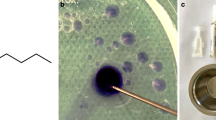Abstract
Background
The objective was to assess the surgical results in complex middle cerebral artery (MCA) aneurysms.
Methods
From 1999 to 2009 the data of 330 patients with ruptured and unruptured MCA aneurysms were included into a prospective database. Degree of aneurysm occlusion and clinical outcomes were analysed after 271 surgical and 59 endovascular treatments assigned in an interdisciplinary approach. Aneurysms of large size and/or broad base, calcifications, and incorporation of M1 or M2 segments into the aneurysm base were defined as complex.
Findings
At least one of the criteria for complexity mentioned above was met in 97.8% of the MCA aneurysms that were treated surgically and in 76.3% that were treated endovascularly. In MCA aneurysms treated surgically, complete occlusion was achieved in 264 of the 271 (97.4%) aneurysms. Aneurysms with remnants after surgical treatment were significantly larger in size (17 ± 3 mm vs 7 ± 5 mm), and exhibited significantly more often parent vessel involvement (M1: 86% vs 27%; M2: 100% vs 67%) compared with the group of aneurysms that could be treated without remnant. Compared with our institutional data (52.5% complete occlusion rate) and data of the literature (up to 46.1% complete occlusion rate), the occlusion rates of endovascularly treated MCA aneurysms were significantly lower compared with MCA aneurysms treated surgically.
Conclusions
Surgical treatment of ruptured and unruptured MCA aneurysms results in a significantly higher rate of complete aneurysm occlusion compared with endovascular treatment, despite a high rate of complex aneuryms in the surgically treated group.
Similar content being viewed by others
References
Bracard S, Abdel-Kerim A, Thuillier L, Klein O, Anxionnat R, Finitsis S, Lebedinsky A, de Freitas CM, Pinheiro N, de Andrade GC, Picard L (2010) Endovascular coil occlusion of 152 middle cerebral artery aneurysms: initial and midterm angiographic and clinical results. J Neurosurg 112:703–708
Investigators CARAT (2006) Rates of delayed rebleeding from intracranial aneurysms are low after surgical and endovascular treatment. Stroke 37:1437–1442
Choi DS, Kim MC, Lee SK, Willinsky RA, Terbrugge KG (2010) Clinical and angiographic long-term follow-up of completely coiled intracranial aneurysms using endovascular technique. J Neurosurg 112:575–581
Elijovich L, Higashida RT, Lawton MT, Duckwiler G, Giannotta S, Johnston SC (2008) Predictors and outcomes of intraprocedural rupture in patients treated for ruptured intracranial aneurysms: the CARAT study. Stroke 39:1501–1506
Flamm ES, Grigorian AA, Marcovici A (2000) Multifactorial analysis of surgical outcome in patients with unruptured middle cerebral artery aneurysms. Ann Surg 232:570–575
Gerlach R, Beck J, Setzer M, Vatter H, Berkefeld J, de Du Mesnil RR, Raabe A, Seifert V (2007) Treatment related morbidity of unruptured intracranial aneurysms: results of a prospective single centre series with an interdisciplinary approach over a 6 year period (1999–2005). J Neurol Neurosurg Psychiatry 78:864–871
Lubicz B, Collignon L, Raphaeli G, Pruvo JP, Bruneau M, De WO, Leclerc X (2010) Flow-diverter stent for the endovascular treatment of intracranial aneurysms: a prospective study in 29 patients with 34 aneurysms. Stroke 41:2247–2253
Molyneux A, Kerr R, Stratton I, Sandercock P, Clarke M, Shrimpton J, Holman R (2002) International Subarachnoid Aneurysm Trial (ISAT) of neurosurgical clipping versus endovascular coiling in 2143 patients with ruptured intracranial aneurysms: a randomised trial. Lancet 360:1267–1274
Morgan MK, Mahattanakul W, Davidson A, Reid J (2010) Outcome for middle cerebral artery aneurysm surgery. Neurosurgery 67:755–761
Moroi J, Hadeishi H, Suzuki A, Yasui N (2005) Morbidity and mortality from surgical treatment of unruptured cerebral aneurysms at Research Institute for Brain and Blood Vessels-Akita. Neurosurgery 56:224–231
Pierot L, Spelle L, Vitry F (2010) Immediate anatomic results after the endovascular treatment of unruptured intracranial aneurysms: analysis of the ATENA series. AJNR Am J Neuroradiol 31:140–144
Piotin M, Blanc R, Spelle L, Mounayer C, Piantino R, Schmidt PJ, Moret J (2010) Stent-assisted coiling of intracranial aneurysms: clinical and angiographic results in 216 consecutive aneurysms. Stroke 41:110–115
Raabe A, Beck J, Gerlach R, Zimmermann M, Seifert V (2003) Near-infrared indocyanine green video angiography: a new method for intraoperative assessment of vascular flow. Neurosurgery 52:132–139
Raabe A, Seifert V, Schmiedek P, Steinmetz H, Bertalanffy H, Steiger HJ, Stolke D, Forsting M (2002) Recommendations for the management of unruptured intracranial aneurysms. Zentralbl Neurochir 63:70–76
Raaymakers TW, Rinkel GJ, Limburg M, Algra A (1998) Mortality and morbidity of surgery for unruptured intracranial aneurysms: a meta-analysis. Stroke 29:1531–1538
Ringer AJ, Rodriguez-Mercado R, Veznedaroglu E, Levy EI, Hanel RA, Mericle RA, Lopes DK, Lanzino G, Boulos AS (2009) Defining the risk of retreatment for aneurysm recurrence or residual after initial treatment by endovascular coiling: a multicenter study. Neurosurgery 65:311–315
Suzuki S, Tateshima S, Jahan R, Duckwiler GR, Murayama Y, Gonzalez NR, Vinuela F (2009) Endovascular treatment of middle cerebral artery aneurysms with detachable coils: angiographic and clinical outcomes in 115 consecutive patients. Neurosurgery 64:876–888
Wiebers DO, Whisnant JP, Huston J III, Meissner I, Brown RD Jr, Piepgras DG, Forbes GS, Thielen K, Nichols D, O’Fallon WM, Peacock J, Jaeger L, Kassell NF, Kongable-Beckman GL, Torner JC (2003) Unruptured intracranial aneurysms: natural history, clinical outcome, and risks of surgical and endovascular treatment. Lancet 362:103–110
Yahia AM, Latorre JG, Gordon V, Whapham J, Swarnkar A, Fessler RD (2010) Progressive occlusion of aneurysms in Neuroform Stent-assisted treatment of intracranial aneurysms. J Neurol Neurosurg Psychiatry
Conflicts of interest
None.
Author information
Authors and Affiliations
Corresponding author
Rights and permissions
About this article
Cite this article
Güresir, E., Schuss, P., Berkefeld, J. et al. Treatment results for complex middle cerebral artery aneurysms. A prospective single-center series. Acta Neurochir 153, 1247–1252 (2011). https://doi.org/10.1007/s00701-011-1008-3
Received:
Accepted:
Published:
Issue Date:
DOI: https://doi.org/10.1007/s00701-011-1008-3




